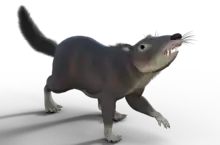Triconodon
Triconodon ("three coned tooth") is a genus of extinct mammal from the Early Cretaceous of England and France with two known species: T. mordax and T. averianovi. First described in 1859 by Richard Owen,[1] it is the type genus for the order Triconodonta, a group of mammals characterised by their three-cusped (triconodont) molar teeth. Since then, this "simplistic" type of dentition has been understood to be either ancestral for mammals or else to have evolved multiple times, rendering "triconodonts" a paraphyletic or polyphyletic assemblage respectively, but several lineages of "triconodont" mammals do form a natural, monophyletic group, known as Eutriconodonta, of which Triconodon is indeed part of.
| Triconodon | |
|---|---|
| Triconodon mordax jaw, Richard Owen 1861 | |
| Scientific classification | |
| Kingdom: | Animalia |
| Phylum: | Chordata |
| Class: | Mammalia |
| Order: | †Eutriconodonta |
| Family: | †Triconodontidae |
| Genus: | †Triconodon Owen, 1859 |
| Type species | |
| †Triconodon mordax Owen, 1859 | |
| Other species | |
| |
| Synonyms | |
| |
Triconodon, therefore, is significant in the understanding of the evolution of mammals by originating the understanding of the "triconodont" grade and eutriconodont clade. Further discoveries on its skeletal anatomy also offer further insights on the palaeobiology of Mesozoic mammals.[2]
Discovery
The type specimen of Triconodon is BMNH 47764, a single mandible found in the Purbeck Group, England, pertaining to the type species (T. mordax).[1] Since then, several other specimens have been found in this region, mostly represented by skulls and jaws, making it the most common mammal fossils in this area of Britain.[2] These deposits date to the earliest Cretaceous, to the Berriasian at around 145-140 million years of age. The second species, T. averianovi, was named in 2020 based on fossils found in the Berriasian-aged Lulworth Formation, England.[3]
A single specimen has also been found in the Champblanc Quarry in France, dating to roughly the same age. It is unclear if it belongs to the same species as the British form, though given the close temporal and geographical proximity it seems likely.[4]
Classification
Triconodon is known from two species, represented only by T. averianovi and T. mordax (though see above). Besides being the type genus and species for Eutriconodonta as seen above, it is also the type genus and species for Triconodontidae, erected in 1887 by Charles Marsh.[5] Within this group it is usually recovered in a basal position, sometimes as sister taxa to Trioracodon,[6][7] or closer to the group containing the rest of the clade, rendering Trioracodon in the basalmost position.[8]
Biology
Like most eutriconodonts, Triconodon was probably a carnivore, its triconodont teeth being well adapted for shearing, and possessing other speciations such as long canines and powerful jaw musculature.[2] It was about as large as a modern cat, suggesting that it hunted vertebrate prey such as other mammals or small dinosaurs.[9] A study detailing Mesozoic mammal diets ranks it among carnivorous taxa.[10]
Tooth replacement
Triconodon is one of the few Mesozoic mammals with direct evidence of tooth eruption, thanks to a broad ontogenetic range presented by the specimens. Through several juvenile specimens we can document the replacement of its lower fourth premolar, erupting and coming into use when at least three out of its four molars were already fully erupted.[11]
Brain
One of the earliest fossil brain endocast studies has been performed for Triconodon.[11] The olfactory lobe is large, with a teardrop-shaped outline, suggesting a well developed sense of smell.
The cerebral hemisphere is long, oval and flat, lacking the inflated appearance present in monotremes, multituberculates and therians. The cerebrum is neither expanded anteriorly to overlap the posterior part of the olfactory lobe, nor is it hemispherical. It is similar to that of multituberculates in that it has a large, roughly triangular bulge, now thought to be the superior cistern. The midbrain was apparently exposed to the dorsal side of the brain as with many other non-therian mammals.[2]
What this indicates about the animal's intelligence is currently unclear, though its overall brain proportions are somewhat smaller than those of more derived mammals like multituberculates and therians.[12]
References
- R. Owen. 1859. Palaeontology. Encyclopedia Britannica, 8th ed. 17:91-176 [P. Wagner/P. Wagner]
- Zofia Kielan-Jaworowska, Richard L. Cifelli, Zhe-Xi Luo (2004). "Chapter 7: Eutriconodontans". Mammals from the Age of Dinosaurs: origins, evolution, and structure. New York: Columbia University Press. pp. 216–248. ISBN 0-231-11918-6.CS1 maint: multiple names: authors list (link)
- Kai R. K. Jäger; Richard L. Cifelli; Thomas Martin (2020). "Tooth eruption in the Early Cretaceous British mammal Triconodon and description of a new species". Papers in Palaeontology. Online edition. doi:10.1002/spp2.1329.
- J. Pouech, J.-M. Mazin, and J.-P. Billon-Bruyat. 2006. Microvertebrate biodiversity from Cherves-de-Cognac (Lower Cretaceous, Berriasian: Charente, France). 9th International Symposium on Mesozoic Terrestrial Ecosystems and Biota, Abstracts and Proceedings Volume 96-100 [M. Carrano/M. Carrano]
- O. C. Marsh. 1887. American Jurassic mammals. The American Journal of Science, series 3 33(196):327-348
- Marisol Montellano; James A. Hopson; James M. Clark (2008). "Late Early Jurassic Mammaliaforms from Huizachal Canyon, Tamaulipas, México". Journal of Vertebrate Paleontology 28 (4): 1130–1143. doi:10.1671/0272-4634-28.4.1130.
- Chun-Ling Gao, Gregory P. Wilson, Zhe-Xi Luo, A. Murat Maga, Qingjin Meng and Xuri Wang (2010). "A new mammal skull from the Lower Cretaceous of China with implications for the evolution of obtuse-angled molars and ‘amphilestid’ eutriconodonts". Proceedings of the Royal Society B: Biological Sciences 277 (1679): 237–246. doi:10.1098/rspb.2009.1014. PMC 2842676. PMID 19726475.
- Thomas Martin, Jesús Marugán-Lobón, Romain Vullo, Hugo Martín-Abad, Zhe-Xi Luo & Angela D. Buscalioni (2015). A Cretaceous eutriconodont and integument evolution in early mammals. Nature 526, 380–384. doi:10.1038/nature14905
- David M. Grossnickle, P. David Polly, Mammal disparity decreases during the Cretaceous angiosperm radiation, Published 2 October 2013. doi:10.1098/rspb.2013.2110
- G. G. Simpson. 1928. A Catalogue of the Mesozoic Mammalia in the Geological Department of the British Museum 1-215
- Harry Jerison, Evolution of The Brain and Intelligence, 02/12/2012





